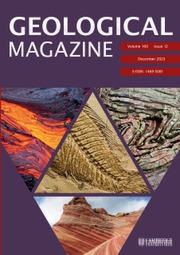Crossref Citations
This article has been cited by the following publications. This list is generated based on data provided by
Crossref.
Stouge, Svend
Bagnoli, Gabriella
and
Rasmussen, Jan A.
2020.
Late Cambrian (Furongian) to mid-Ordovician euconodont events on Baltica: Invasions and immigrations.
Palaeogeography, Palaeoclimatology, Palaeoecology,
Vol. 549,
Issue. ,
p.
109151.
Karato, Shun-ichiro
Karki, Bijaya
and
Park, Jeffrey
2020.
Deep mantle melting, global water circulation and its implications for the stability of the ocean mass.
Progress in Earth and Planetary Science,
Vol. 7,
Issue. 1,
Herbosch, Alain
Liégeois, Jean-Paul
Gärtner, Andreas
Hofmann, Mandy
and
Linnemann, Ulf
2020.
The Stavelot-Venn Massif (Ardenne, Belgium), a rift shoulder basin ripped off the West African craton: Cartography, stratigraphy, sedimentology, new U-Pb on zircon ages, geochemistry and Nd isotopes evidence.
Earth-Science Reviews,
Vol. 203,
Issue. ,
p.
103142.
Hou, Zhang-shuai
Fan, Jun-xuan
Henderson, Charles M.
Yuan, Dong-xun
Shen, Bo-heng
Wu, Jie
Wang, Yue
Zheng, Quan-feng
Zhang, Yi-chun
Wu, Qiong
and
Shen, Shu Zhong
2020.
Dynamic palaeogeographic reconstructions of the Wuchiapingian Stage (Lopingian, Late Permian) for the South China Block.
Palaeogeography, Palaeoclimatology, Palaeoecology,
Vol. 546,
Issue. ,
p.
109667.
Parsons, Andrew J.
Hosseini, Kasra
Palin, Richard M.
and
Sigloch, Karin
2020.
Geological, geophysical and plate kinematic constraints for models of the India-Asia collision and the post-Triassic central Tethys oceans.
Earth-Science Reviews,
Vol. 208,
Issue. ,
p.
103084.
Guan, Qingbin
Liu, Yongjiang
Neubauer, Franz
Li, Sanzhong
Genser, Johann
Yuan, Sihua
Chang, Ruihong
Huang, Qianwen
and
Fang, Qiang
2021.
Opening of the West Paleo-Tethys Ocean: New insights from earliest Devonian meta-mafic rocks in the Saualpe crystalline basement, Eastern Alps.
Gondwana Research,
Vol. 97,
Issue. ,
p.
121.
2021.
Glacially-Triggered Faulting.
p.
261.
Müller, Katharina
Winsemann, Jutta
Tanner, David C.
Lege, Thomas
Spies, Thomas
and
Brandes, Christian
2021.
Glacially-Triggered Faulting.
p.
283.
McSweeney, Fearghus R.
Shimeta, Jeff
and
Buckeridge, John St. J.S.
2021.
Lower Devonian (Pragian–Emsian) land plants from Alexandra: an early window into the diversity of Victorian flora from southeastern Australia.
Alcheringa: An Australasian Journal of Palaeontology,
Vol. 45,
Issue. 3,
p.
315.
McSweeney, Fearghus R.
Shimeta, Jeff
and
Buckeridge, John St. J. S.
2021.
Yarravia oblongaLang& Cookson, 1935 emended, from the Lower Devonian of Victoria, Australia.
Alcheringa: An Australasian Journal of Palaeontology,
Vol. 45,
Issue. 3,
p.
299.
Müller, R. Dietmar
Flament, Nicolas
Cannon, John
Tetley, Michael G.
Williams, Simon E.
Cao, Xianzhi
Bodur, Ömer F.
Zahirovic, Sabin
and
Merdith, Andrew
2022.
A tectonic-rules-based mantle reference frame since 1 billion years ago – implications for supercontinent cycles and plate–mantle system evolution.
Solid Earth,
Vol. 13,
Issue. 7,
p.
1127.
Edward, Oluwaseun
Korte, Christoph
Ullmann, Clemens V.
Colmenar, Jorge
Thibault, Nicolas
Bagnoli, Gabriella
Stouge, Svend
and
Rasmussen, Christian M. Ø.
2022.
A Baltic Perspective on the Early to Early Late Ordovician δ13C and δ18O Records and Its Paleoenvironmental Significance.
Paleoceanography and Paleoclimatology,
Vol. 37,
Issue. 3,
Peng, Wenxiao
Yang, Tianshui
Shi, Yuruo
Bian, Weiwei
Ma, Yiming
Wang, Suo
Jiao, Xianwei
Ma, Jiahui
Kang, Yuelan
Zhang, Shihong
Wu, Huaichun
and
Li, Haiyan
2022.
Role of the Kerguelen mantle plume in breakup of eastern Gondwana: Evidence from early cretaceous volcanic rocks in the eastern Tethyan Himalaya.
Palaeogeography, Palaeoclimatology, Palaeoecology,
Vol. 588,
Issue. ,
p.
110823.
Zhuravlev, Andrey Yu.
Mitchell, Emily G.
Bowyer, Fred
Wood, Rachel
and
Penny, Amelia
2022.
Increases in reef size, habitat and metacommunity complexity associated with Cambrian radiation oxygenation pulses.
Nature Communications,
Vol. 13,
Issue. 1,
Monti, Daniela S.
Confalonieri, Viviana A.
and
Tortello, M. Franco
2023.
The Central Andean Basin as a dispersal centre: Biogeographic patterns of olenid trilobites during the late Cambrian – Early Ordovician.
Palaeogeography, Palaeoclimatology, Palaeoecology,
Vol. 618,
Issue. ,
p.
111519.
van Staal*, Cees R.
and
Zagorevski*, Alex
2023.
Laurentia: Turning Points in the Evolution of a Continent.
p.
487.
Zhuravlev, Andrey Yu.
Wood, Rachel A.
and
Bowyer, Fred T.
2023.
Cambrian radiation speciation events driven by sea level and redoxcline changes on the Siberian Craton.
Science Advances,
Vol. 9,
Issue. 24,
Zhong, Ziqi
Xia, Jinkai
Huang, Shaoying
Luo, Caiming
Chang, Haining
Li, Xiang
Wei, Lunyan
and
Zhang, Hao
2023.
Reconstruction of proto-type basin and tectono-paleogeography of Tarim block in early Paleozoic.
Frontiers in Earth Science,
Vol. 11,
Issue. ,
LARDEAUX, Jean‐Marc
and
SCHULMANN, Karel
2023.
The Variscan Belt of Western Europe 1.
p.
47.
WANG, Luojing
LÜ, Dawei
ZHANG, Zhihui
HOWER, James C.
RAJI, Munira
ZHANG, Yushuai
SHEN, Yangyang
and
GAO, Jie
2023.
Geochronology, Mineralogy, and Geochemistry of the Tonsteins from the Permo–Carboniferous Benxi Formation, Ordos Basin, North China Craton.
Acta Geologica Sinica - English Edition,
Vol. 97,
Issue. 5,
p.
1355.




